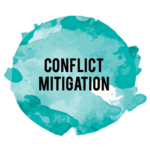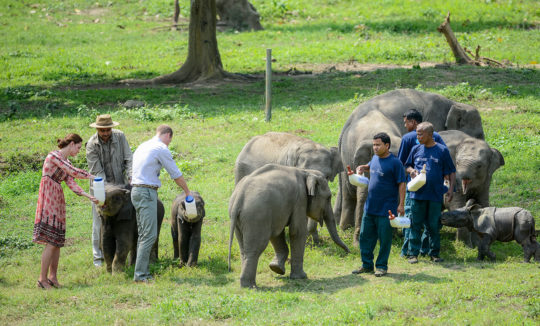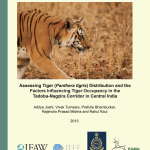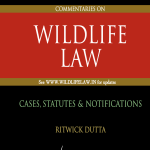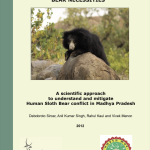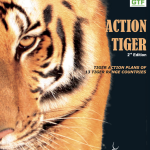Project Info
Project Description
IN THE NORTHERN STATE OF UTTAR PRADESH, about 75 cases of human-wildlife conflict had been recorded between 2003 to 2009 by the State Forest Department (as per available records), with majority of the cases (89.3%) pertaining to the two big cat species found in the state, the leopard (Panthera pardus) (42.67%) and the Bengal tiger (Panthera tigris) (46.67%). The remaining involved other large wildlife species such as the sloth bear (Melursus ursinus), Elephants (Elephas maximus) and the Indian marsh crocodile (Crocdylus palustris).
In these recorded cases, several humans have lost their lives (42 persons) or injured (39 persons) at the hands of various individual tigers and leopards. An additional 474 cases recorded for the same period, have resulted in livestock deaths. However, no detailed records exist of the exact number of tiger and leopard deaths as a result of these conflicts, primarily because a number of retaliatory killings can go undetected, especially if animals are tactically killed through poisoning or trapping.
Almost all of the cases were recorded from the Dudhwa and Pilibhit TR Landscape in the north-eastern fringe of the state, bordering with Nepal. This landscape harbours about 124 tigers as per the latest estimates by the National Tiger Conservation Authority (NTCA), and while the number of leopards is believed to be relatively higher in number than tigers, no rough estimates exist yet for the Protected Areas (PA) of the landscape.

Figure 1: Number of reported human-big cat conflict situations from the Duhdwa and Pilibhit landscape in Uttar Pradesh, between 2003 and 2010. Note, trend lines do not indicate regressions trends, and are only for aiding visual interpretation of the prevalent trends.
ESTABLISHING A PRESENCE THROUGH TERAI TIGER PROJECT
Based on this information, the Uttar Pradesh Big Cat Conflict Mitigation project (also called the Terai Tiger Project) was launched by the Wildlife Trust of India, in collaboration with the State Forest Department of Uttar Pradesh, in 2009. The launch, saw the establishment of a Mobile Veterinary Service (MVS) in the Dudhwa-Pilibhit TR landscape, equipped with a four-wheel drive vehicle and a trained wildlife veterinarian to rescue leopards and tigers involved in conflict situations.
The MVS between 2009 and 2011 however was able to address only five cases of conflict, rescuing two tigers and three leopards, and it was soon realised that while, the number of reported cases being reported from the landscape were increasing, most remained unaddressed.
Between 2009 and 2011 however, the number of cases being reported had increased by almost 200%, with on average 5.8 cases per year between 2003 and 2008, to around 15.6 cases one average per year, between 2009 and 2011. Consequently a number of these cases remained unresolved, many taking a toll on individual tigers and leopards.
The project has till date relocated three tigers from conflict situations in villages and towns to forested regions of the nearby Protected Areas.
It was with this shortcoming in mind, that the Wildlife Trust of India, re-vamped the project framework from addressing human-big cat conflicts by solely attempting to rescue the animals involved, to reducing such conflicts using a multi-pronged model that focused majorly on developing integrative, participatory approaches towards conflict mitigation.
Partnering with Aircel Pvt. Ltd. under its Save our Tigers Campaign, for financial support, the Terai Tiger Project in its evolved form, was re-vamped by early 2012. Between 2012 and 2014, the project through its multi-pronged approach helped reduce this conflict by about 51.1%. A reduction in just two years, from the escalated average of 15.6 reports per year, to about eight cases on average per year.

Figure 2: The multi-pronged strategy employed in the project since 2012 to present.
TERAI TIGER PROJECT – A MULTI-PRONGED APPROACH
One of the key thrust areas of this re-vamped Terai Tiger Project lay in its integrative approach that promoted the formalisation of a participatory model of human-wildlife conflict mitigation. Meticulous information gathering through opportunistic case reports, surveys of potentially conflict prone villages around the PAs recording case histories, Land Use Land Cover (LULC) attributes, as well as local attitudes towards conflict animals and other wildlife, along with numerous consultative meetings with villagers, the project constituted nine Primary Response Teams (PRT) by the end of 2012. Each of these teams constitute 4-5 local village volunteers and one or two local forest guards, and are responsible for addressing human-wildlife conflict situations on the ground as primary responders.

WTI RRT setting up camera traps in the field | Photograph by Madhumay Mallik/WTI
Some of the key voluntary responsibilities of PRTs include; immediate relaying of information about a conflict situation to the project team and the local Forest Department office, locating the animal involved, inhibiting formation of crowds, driving the animal in case of attacks on humans or livestock, rescuing attack victims, administering first aid care, rushing victims to medical emergency establishments if required, conducting night patrolling, liaising with the State Forest Department for speedy disbursement of relief sums, and where possible tracking the whereabouts of the animal. PRTs operate in not only their respective villages, but also in adjoining villages and hamlets (see map 1), and are periodically trained and equipped to execute their tasks with greater efficiency.
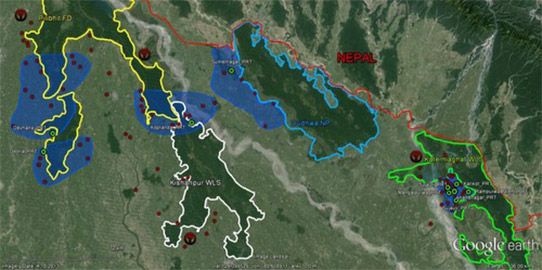
Map 1: Satellite image showing locations of PRT (green dots) in the different TR forest divisions in the Dudhwa and Pilibhit TR landscape and approximate areas covered by each PRT (blue polygons). Red question marks in circles indicate proposed areas where new PRTs are envisaged to be established
The network of established PRTs in the region, is further supported by a Rapid response Team that is equipped with not only the MVS vehicle but an arsenal of equipment and paraphernalia for crowd control, monitoring movements of big cats, as well as for trapping, chemical immobilisation and transporting of wild animals.
One key activity has been towards spreading awareness and education about wildlife in general and about human-wildlife conflict in particular.
The RRT engages along with PRTs and the local Forest Department in cases that aggravate (second attack on a human being) in intensity, with a two tier aim, first to resolve the situation through active crowd control followed by monitoring to ensure the animal returns safely to the forest without attacking any human being or livestock and not being killed or injured itself, and secondly through direct intervention, requiring the animal to be physically caught.
The project till date has relocated three tigers from conflict situations in villages and towns to forested areas of the PAs. One particular case has provided recent evidence of long-term success of relocating a tiger involved in conflict, i.e. a camera trap photograph of the relocated male tiger surviving into its fourth year within the PA and not being involved in any conflict situations so far.
In addition to these major thrust areas, the project also strived at implementing various activities with the aim of long-term sustainable change in mind. One such key activity has been towards spreading awareness and education about wildlife in general and about human-wildlife conflict in particular.

Figure 3: Histogram showing the number of reported cases since project launch and through the period of its re-vamping. Yellow double ended arrows indicate period of specific interventions.Note, trend lines do not indicate regressions trends, and are only for aiding visual interpretation of the prevalent trends.
Between 2011 and 2014, about awareness events have been organised in about 62 villages in the region, addressing over 5800 villagers, while about 41 children’s awareness events were organised in rural schools sensitising above 4000 school rural children. The project has also provided several posters and signboards that have been erected at various key hotspot villages to educate villagers further on the precautionary measures to take during ongoing big cat related conflict situations.
In the year 2022-23, out of 41 big cat conflict cases attended by the RRT, the team ensured safe passage to 32 big cats; and captured five to be released back to the wild. Other than that, the RRT also attended to 17 wildlife rescue and release cases including porcupine, spotted deer, elephant and snake rescue. The team also organized an elephant foot care-cum-health check-up camp with 14 mahouts and their assistants in the landscape. Today, there are close to 98 PRT members in the Terai Tiger Project region spanning across 57 villages abutting three protected areas.
The Terai Tiger Project also works on school-level and 39 village-level awareness events. Mega awareness camps through cycle rallies in Katerniaghat have been tools to raise conservation awareness through education. We have also initiated the development of a Terai Education Centre in collaboration with the Chester Zoo team.
Lastly the project has also strived to conduct detailed scientific assessments of the distribution of tigers, leopards and their principal prey species in the PAs of Dudhwa-Pilibhit TR.
PARTNERS: Uttar Pradesh Forest Department / U.S. Fish and Wildlife Services / Chester Zoo
PROJECT LEAD: Abhishek Ghoshal
